coolant temperature CHEVROLET CORVETTE 2004 5.G User Guide
[x] Cancel search | Manufacturer: CHEVROLET, Model Year: 2004, Model line: CORVETTE, Model: CHEVROLET CORVETTE 2004 5.GPages: 384, PDF Size: 2.46 MB
Page 175 of 384
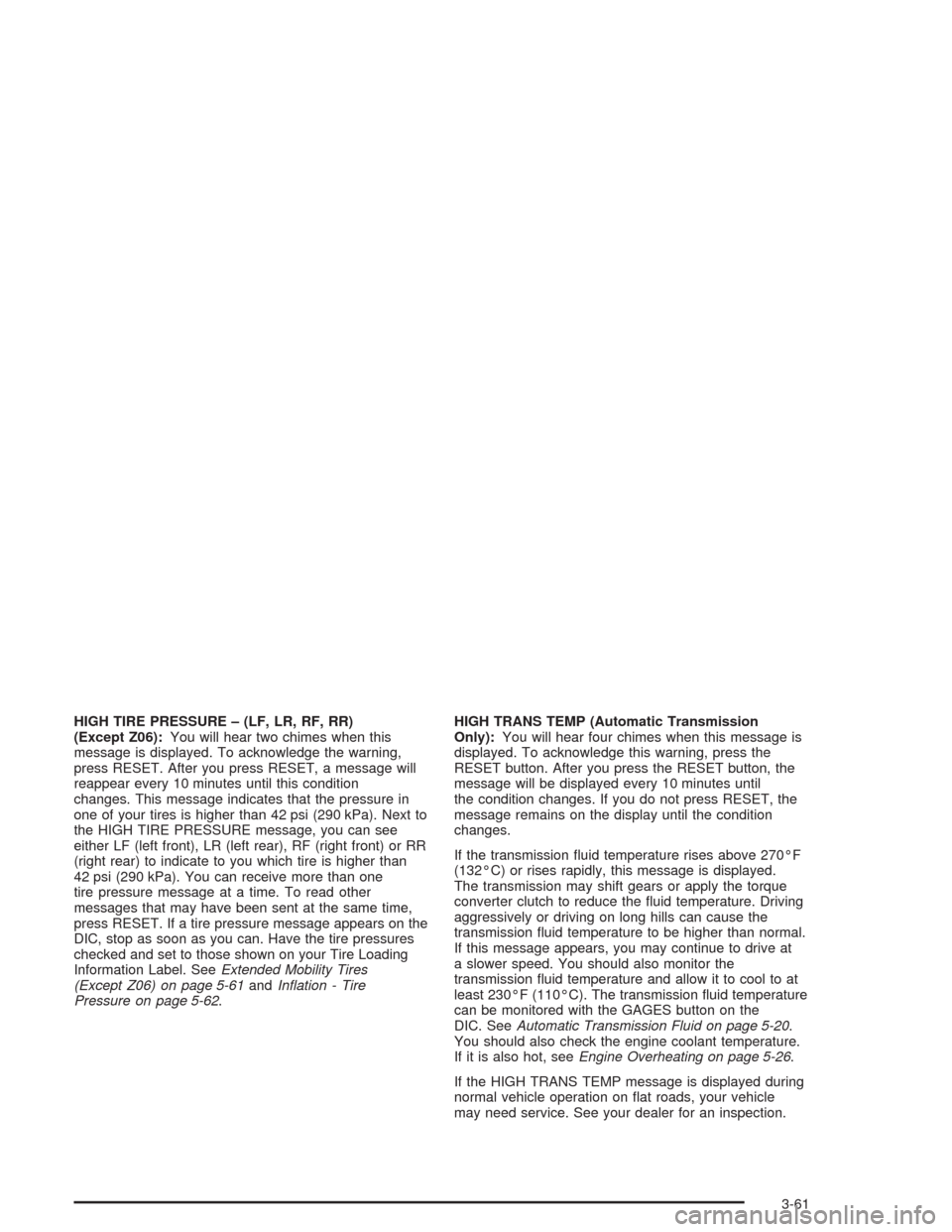
HIGH TIRE PRESSURE – (LF, LR, RF, RR)
(Except Z06):You will hear two chimes when this
message is displayed. To acknowledge the warning,
press RESET. After you press RESET, a message will
reappear every 10 minutes until this condition
changes. This message indicates that the pressure in
one of your tires is higher than 42 psi (290 kPa). Next to
the HIGH TIRE PRESSURE message, you can see
either LF (left front), LR (left rear), RF (right front) or RR
(right rear) to indicate to you which tire is higher than
42 psi (290 kPa). You can receive more than one
tire pressure message at a time. To read other
messages that may have been sent at the same time,
press RESET. If a tire pressure message appears on the
DIC, stop as soon as you can. Have the tire pressures
checked and set to those shown on your Tire Loading
Information Label. SeeExtended Mobility Tires
(Except Z06) on page 5-61andIn�ation - Tire
Pressure on page 5-62.HIGH TRANS TEMP (Automatic Transmission
Only):You will hear four chimes when this message is
displayed. To acknowledge this warning, press the
RESET button. After you press the RESET button, the
message will be displayed every 10 minutes until
the condition changes. If you do not press RESET, the
message remains on the display until the condition
changes.
If the transmission fluid temperature rises above 270°F
(132°C) or rises rapidly, this message is displayed.
The transmission may shift gears or apply the torque
converter clutch to reduce the fluid temperature. Driving
aggressively or driving on long hills can cause the
transmission fluid temperature to be higher than normal.
If this message appears, you may continue to drive at
a slower speed. You should also monitor the
transmission fluid temperature and allow it to cool to at
least 230°F (110°C). The transmission fluid temperature
can be monitored with the GAGES button on the
DIC. SeeAutomatic Transmission Fluid on page 5-20.
You should also check the engine coolant temperature.
If it is also hot, seeEngine Overheating on page 5-26.
If the HIGH TRANS TEMP message is displayed during
normal vehicle operation on flat roads, your vehicle
may need service. See your dealer for an inspection.
3-61
Page 178 of 384
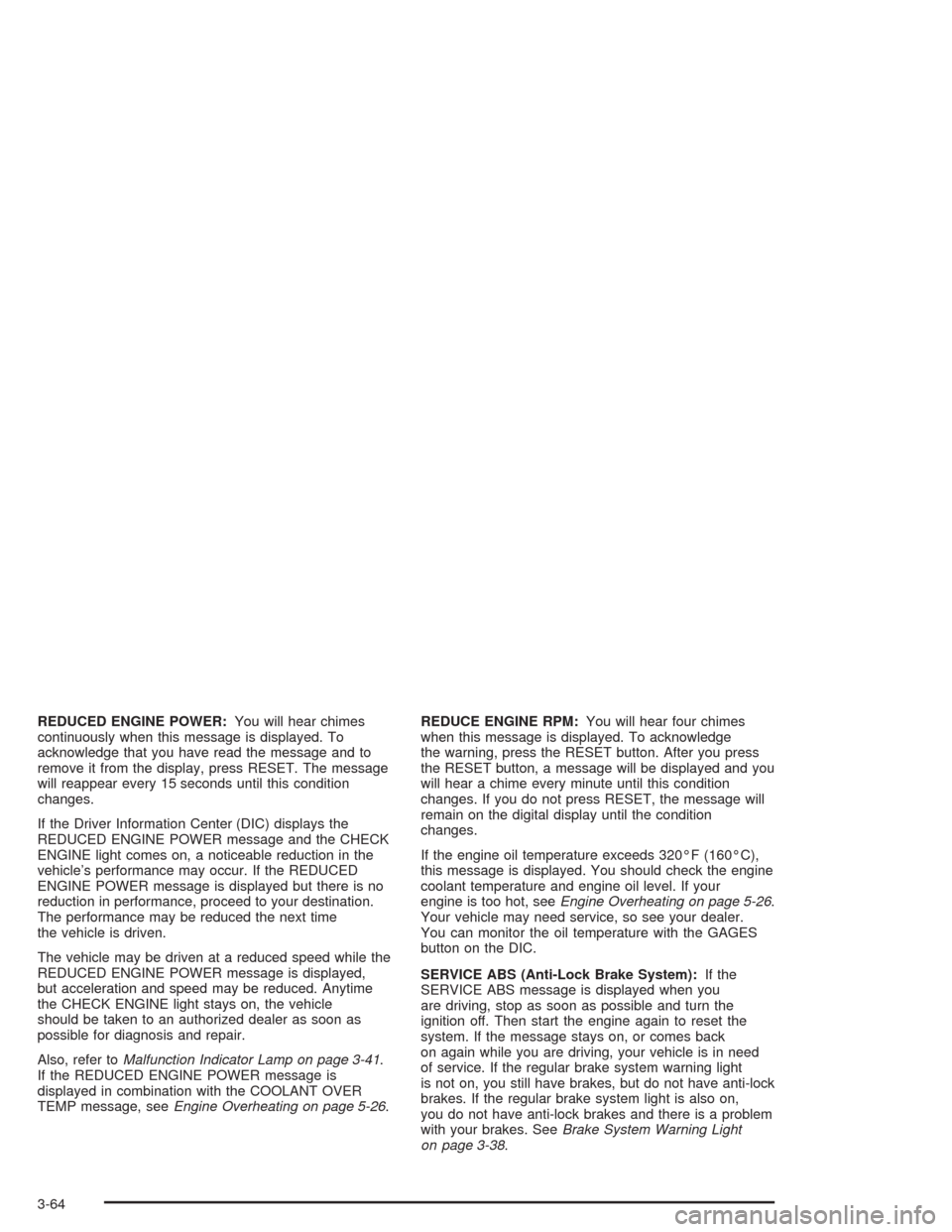
REDUCED ENGINE POWER:You will hear chimes
continuously when this message is displayed. To
acknowledge that you have read the message and to
remove it from the display, press RESET. The message
will reappear every 15 seconds until this condition
changes.
If the Driver Information Center (DIC) displays the
REDUCED ENGINE POWER message and the CHECK
ENGINE light comes on, a noticeable reduction in the
vehicle’s performance may occur. If the REDUCED
ENGINE POWER message is displayed but there is no
reduction in performance, proceed to your destination.
The performance may be reduced the next time
the vehicle is driven.
The vehicle may be driven at a reduced speed while the
REDUCED ENGINE POWER message is displayed,
but acceleration and speed may be reduced. Anytime
the CHECK ENGINE light stays on, the vehicle
should be taken to an authorized dealer as soon as
possible for diagnosis and repair.
Also, refer toMalfunction Indicator Lamp on page 3-41.
If the REDUCED ENGINE POWER message is
displayed in combination with the COOLANT OVER
TEMP message, seeEngine Overheating on page 5-26.REDUCE ENGINE RPM:You will hear four chimes
when this message is displayed. To acknowledge
the warning, press the RESET button. After you press
the RESET button, a message will be displayed and you
will hear a chime every minute until this condition
changes. If you do not press RESET, the message will
remain on the digital display until the condition
changes.
If the engine oil temperature exceeds 320°F (160°C),
this message is displayed. You should check the engine
coolant temperature and engine oil level. If your
engine is too hot, seeEngine Overheating on page 5-26.
Your vehicle may need service, so see your dealer.
You can monitor the oil temperature with the GAGES
button on the DIC.
SERVICE ABS (Anti-Lock Brake System):If the
SERVICE ABS message is displayed when you
are driving, stop as soon as possible and turn the
ignition off. Then start the engine again to reset the
system. If the message stays on, or comes back
on again while you are driving, your vehicle is in need
of service. If the regular brake system warning light
is not on, you still have brakes, but do not have anti-lock
brakes. If the regular brake system light is also on,
you do not have anti-lock brakes and there is a problem
with your brakes. SeeBrake System Warning Light
on page 3-38.
3-64
Page 265 of 384
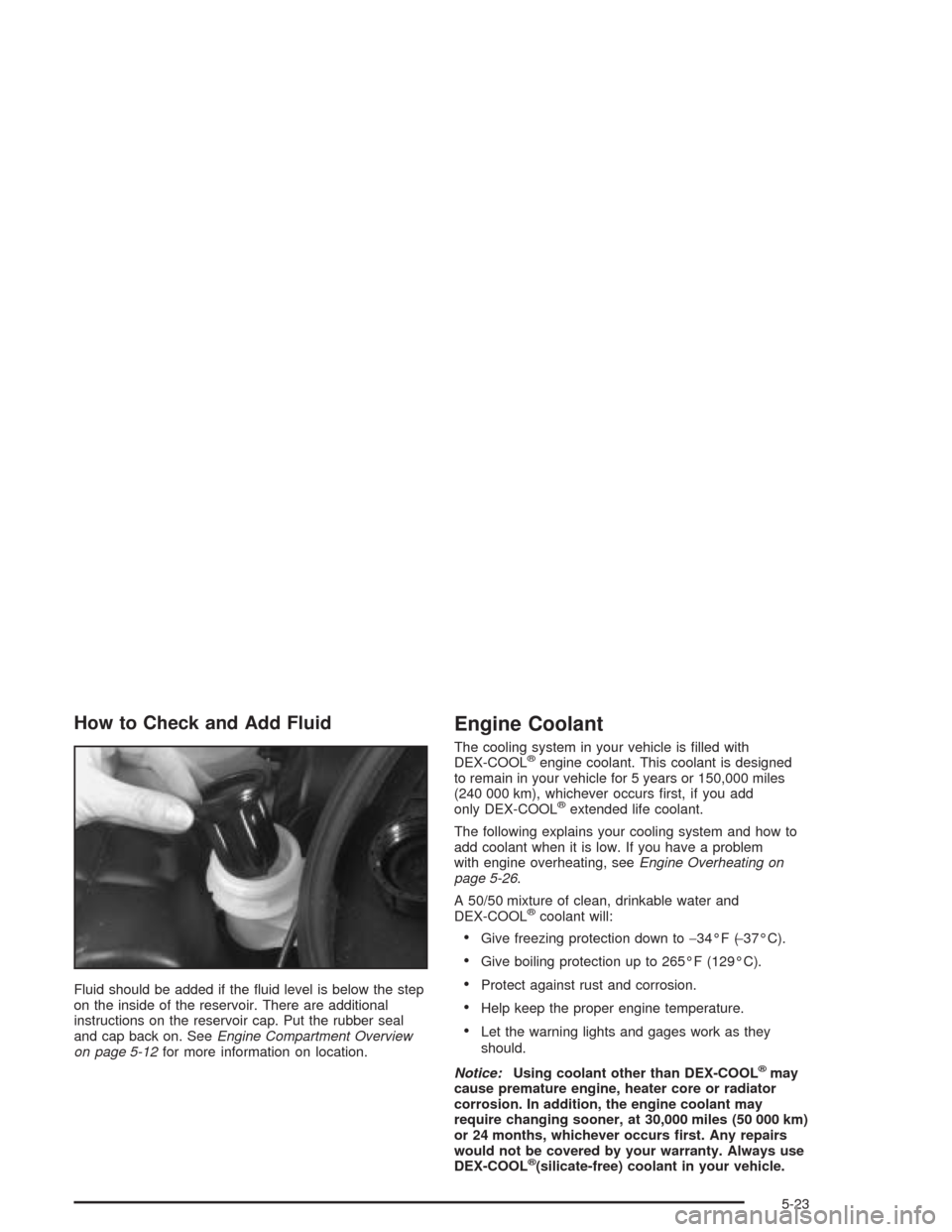
How to Check and Add Fluid
Fluid should be added if the fluid level is below the step
on the inside of the reservoir. There are additional
instructions on the reservoir cap. Put the rubber seal
and cap back on. SeeEngine Compartment Overview
on page 5-12for more information on location.
Engine Coolant
The cooling system in your vehicle is filled with
DEX-COOL®engine coolant. This coolant is designed
to remain in your vehicle for 5 years or 150,000 miles
(240 000 km), whichever occurs first, if you add
only DEX-COOL
®extended life coolant.
The following explains your cooling system and how to
add coolant when it is low. If you have a problem
with engine overheating, seeEngine Overheating on
page 5-26.
A 50/50 mixture of clean, drinkable water and
DEX-COOL
®coolant will:
•Give freezing protection down to−34°F (−37°C).
•Give boiling protection up to 265°F (129°C).
•Protect against rust and corrosion.
•Help keep the proper engine temperature.
•Let the warning lights and gages work as they
should.
Notice:Using coolant other than DEX-COOL
®may
cause premature engine, heater core or radiator
corrosion. In addition, the engine coolant may
require changing sooner, at 30,000 miles (50 000 km)
or 24 months, whichever occurs �rst. Any repairs
would not be covered by your warranty. Always use
DEX-COOL
®(silicate-free) coolant in your vehicle.
5-23
Page 268 of 384
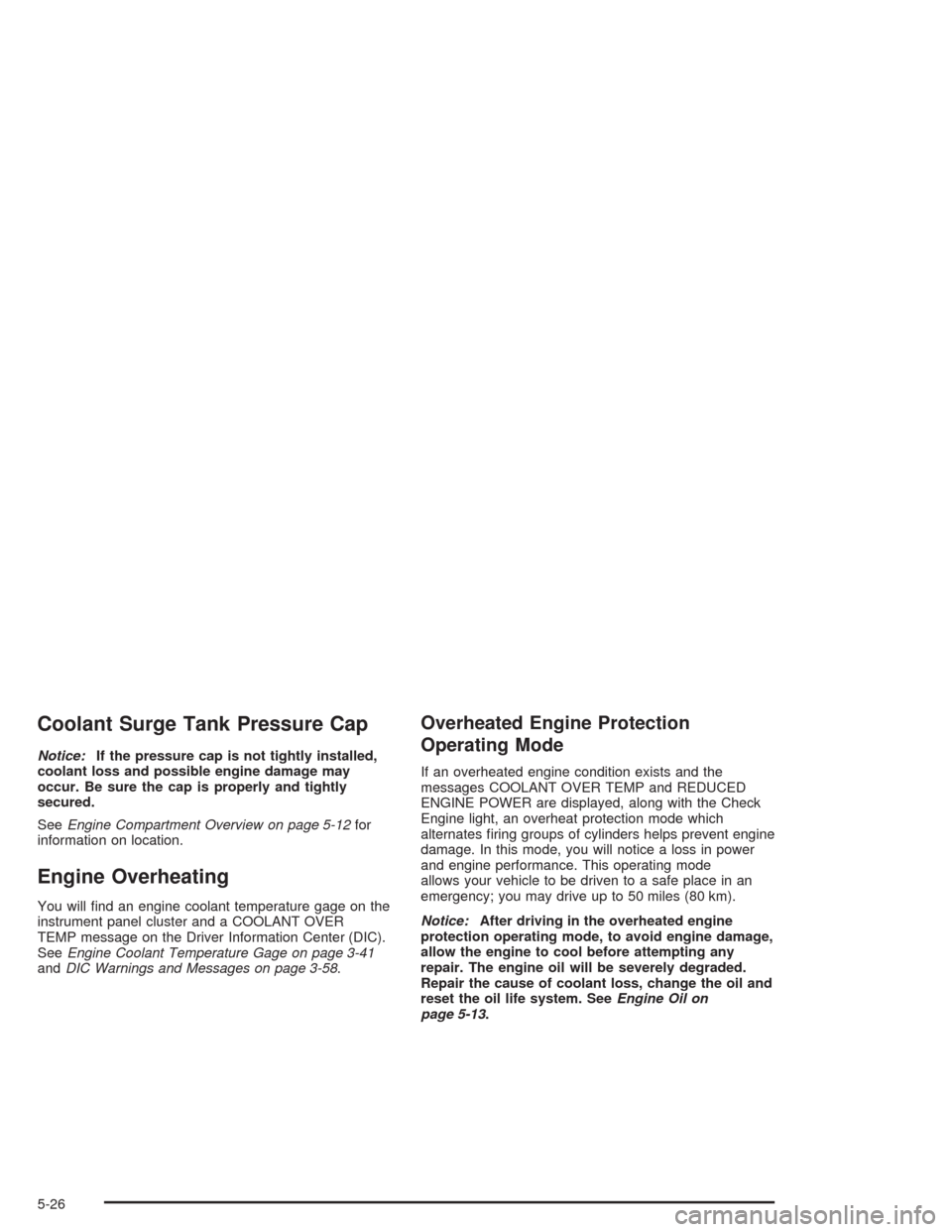
Coolant Surge Tank Pressure Cap
Notice:If the pressure cap is not tightly installed,
coolant loss and possible engine damage may
occur. Be sure the cap is properly and tightly
secured.
SeeEngine Compartment Overview on page 5-12for
information on location.
Engine Overheating
You will find an engine coolant temperature gage on the
instrument panel cluster and a COOLANT OVER
TEMP message on the Driver Information Center (DIC).
SeeEngine Coolant Temperature Gage on page 3-41
andDIC Warnings and Messages on page 3-58.
Overheated Engine Protection
Operating Mode
If an overheated engine condition exists and the
messages COOLANT OVER TEMP and REDUCED
ENGINE POWER are displayed, along with the Check
Engine light, an overheat protection mode which
alternates firing groups of cylinders helps prevent engine
damage. In this mode, you will notice a loss in power
and engine performance. This operating mode
allows your vehicle to be driven to a safe place in an
emergency; you may drive up to 50 miles (80 km).
Notice:After driving in the overheated engine
protection operating mode, to avoid engine damage,
allow the engine to cool before attempting any
repair. The engine oil will be severely degraded.
Repair the cause of coolant loss, change the oil and
reset the oil life system. SeeEngine Oil on
page 5-13.
5-26
Page 278 of 384
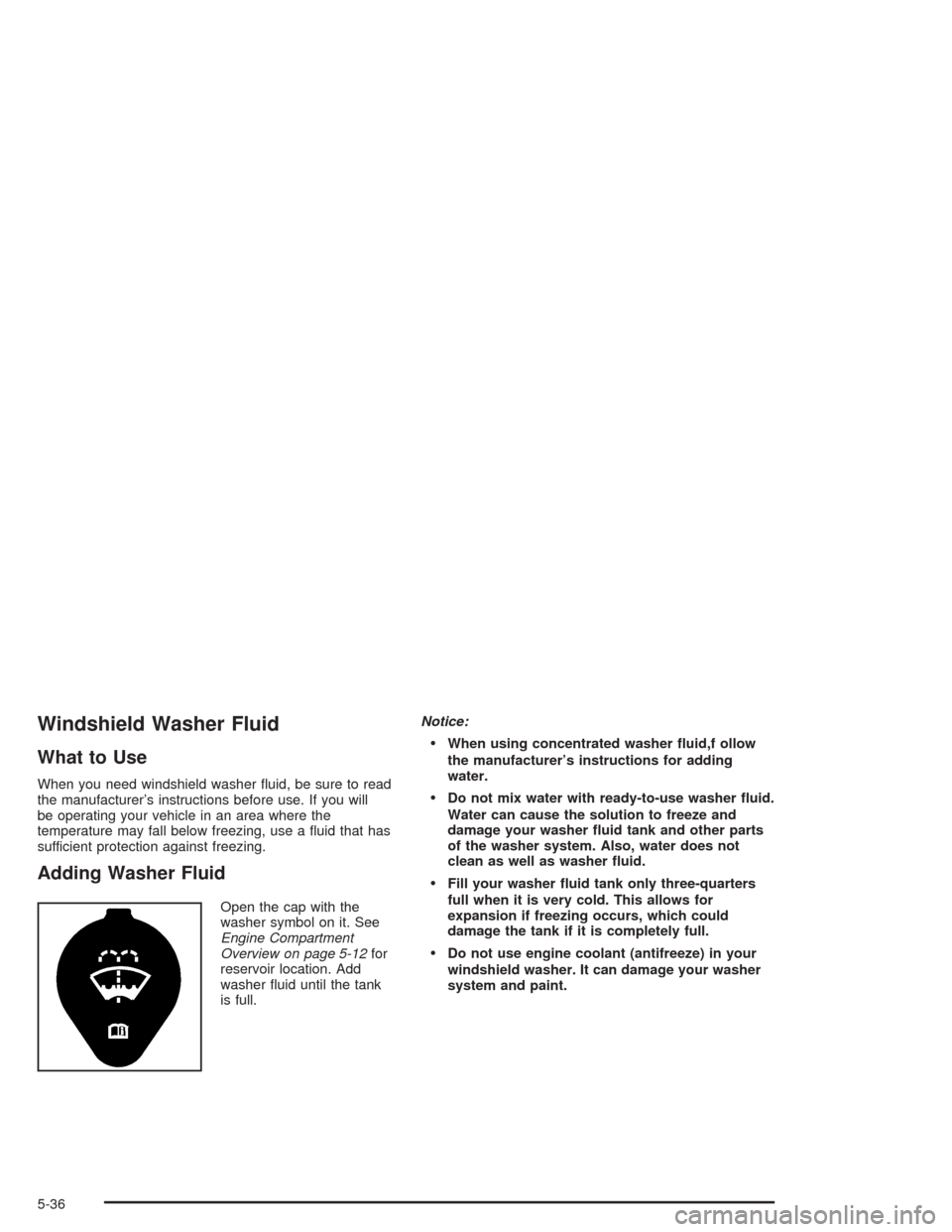
Windshield Washer Fluid
What to Use
When you need windshield washer fluid, be sure to read
the manufacturer’s instructions before use. If you will
be operating your vehicle in an area where the
temperature may fall below freezing, use a fluid that has
sufficient protection against freezing.
Adding Washer Fluid
Open the cap with the
washer symbol on it. See
Engine Compartment
Overview on page 5-12for
reservoir location. Add
washer fluid until the tank
is full.Notice:
When using concentrated washer �uid,f ollow
the manufacturer’s instructions for adding
water.
Do not mix water with ready-to-use washer �uid.
Water can cause the solution to freeze and
damage your washer �uid tank and other parts
of the washer system. Also, water does not
clean as well as washer �uid.
Fill your washer �uid tank only three-quarters
full when it is very cold. This allows for
expansion if freezing occurs, which could
damage the tank if it is completely full.
Do not use engine coolant (antifreeze) in your
windshield washer. It can damage your washer
system and paint.
5-36
Page 350 of 384
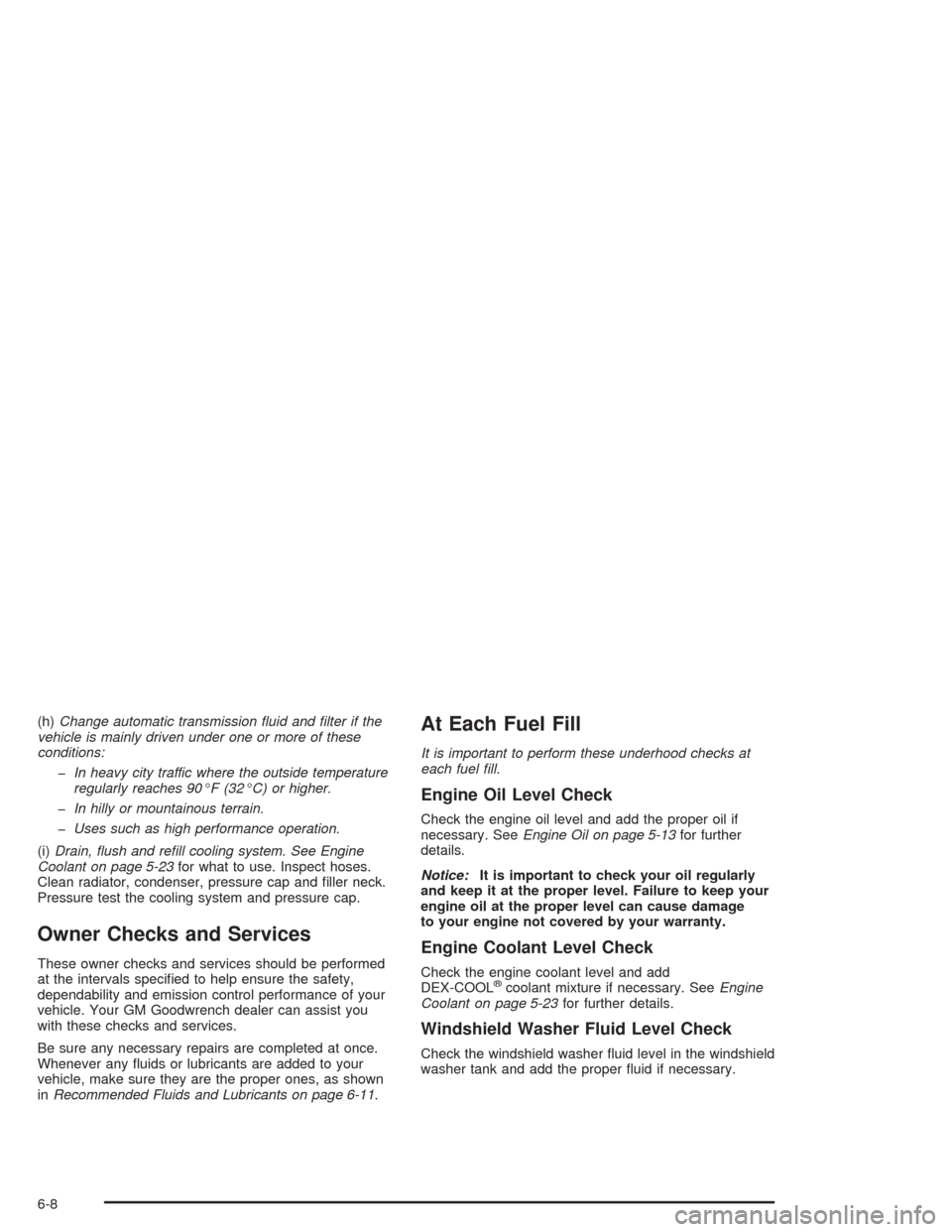
(h)Change automatic transmission �uid and �lter if the
vehicle is mainly driven under one or more of these
conditions:
-In heavy city traffic where the outside temperature
regularly reaches 90°F (32°C) or higher.
-In hilly or mountainous terrain.
-Uses such as high performance operation.
(i)Drain, �ush and re�ll cooling system. See Engine
Coolant on page 5-23for what to use. Inspect hoses.
Clean radiator, condenser, pressure cap and filler neck.
Pressure test the cooling system and pressure cap.
Owner Checks and Services
These owner checks and services should be performed
at the intervals specified to help ensure the safety,
dependability and emission control performance of your
vehicle. Your GM Goodwrench dealer can assist you
with these checks and services.
Be sure any necessary repairs are completed at once.
Whenever any fluids or lubricants are added to your
vehicle, make sure they are the proper ones, as shown
inRecommended Fluids and Lubricants on page 6-11.
At Each Fuel Fill
It is important to perform these underhood checks at
each fuel �ll.
Engine Oil Level Check
Check the engine oil level and add the proper oil if
necessary. SeeEngine Oil on page 5-13for further
details.
Notice:It is important to check your oil regularly
and keep it at the proper level. Failure to keep your
engine oil at the proper level can cause damage
to your engine not covered by your warranty.
Engine Coolant Level Check
Check the engine coolant level and add
DEX-COOL®coolant mixture if necessary. SeeEngine
Coolant on page 5-23for further details.
Windshield Washer Fluid Level Check
Check the windshield washer fluid level in the windshield
washer tank and add the proper fluid if necessary.
6-8
Page 373 of 384
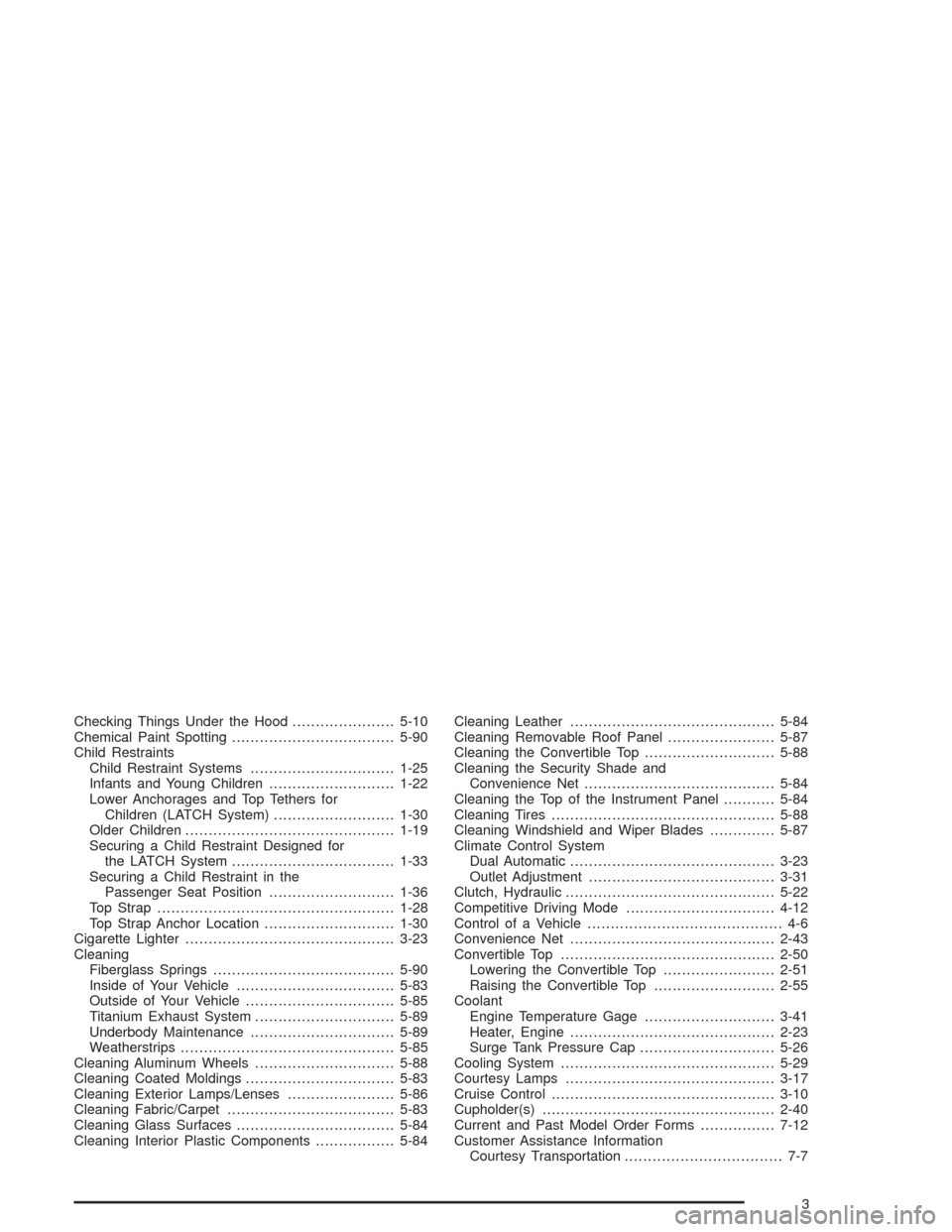
Checking Things Under the Hood......................5-10
Chemical Paint Spotting...................................5-90
Child Restraints
Child Restraint Systems...............................1-25
Infants and Young Children...........................1-22
Lower Anchorages and Top Tethers for
Children (LATCH System)..........................1-30
Older Children.............................................1-19
Securing a Child Restraint Designed for
the LATCH System...................................1-33
Securing a Child Restraint in the
Passenger Seat Position...........................1-36
Top Strap...................................................1-28
Top Strap Anchor Location............................1-30
Cigarette Lighter.............................................3-23
Cleaning
Fiberglass Springs.......................................5-90
Inside of Your Vehicle..................................5-83
Outside of Your Vehicle................................5-85
Titanium Exhaust System..............................5-89
Underbody Maintenance...............................5-89
Weatherstrips..............................................5-85
Cleaning Aluminum Wheels..............................5-88
Cleaning Coated Moldings................................5-83
Cleaning Exterior Lamps/Lenses.......................5-86
Cleaning Fabric/Carpet....................................5-83
Cleaning Glass Surfaces..................................5-84
Cleaning Interior Plastic Components.................5-84Cleaning Leather............................................5-84
Cleaning Removable Roof Panel.......................5-87
Cleaning the Convertible Top............................5-88
Cleaning the Security Shade and
Convenience Net.........................................5-84
Cleaning the Top of the Instrument Panel...........5-84
Cleaning Tires................................................5-88
Cleaning Windshield and Wiper Blades..............5-87
Climate Control System
Dual Automatic............................................3-23
Outlet Adjustment........................................3-31
Clutch, Hydraulic.............................................5-22
Competitive Driving Mode................................4-12
Control of a Vehicle.......................................... 4-6
Convenience Net............................................2-43
Convertible Top..............................................2-50
Lowering the Convertible Top........................2-51
Raising the Convertible Top..........................2-55
Coolant
Engine Temperature Gage............................3-41
Heater, Engine............................................2-23
Surge Tank Pressure Cap.............................5-26
Cooling System..............................................5-29
Courtesy Lamps.............................................3-17
Cruise Control................................................3-10
Cupholder(s)..................................................2-40
Current and Past Model Order Forms................7-12
Customer Assistance Information
Courtesy Transportation.................................. 7-7
3
Page 375 of 384
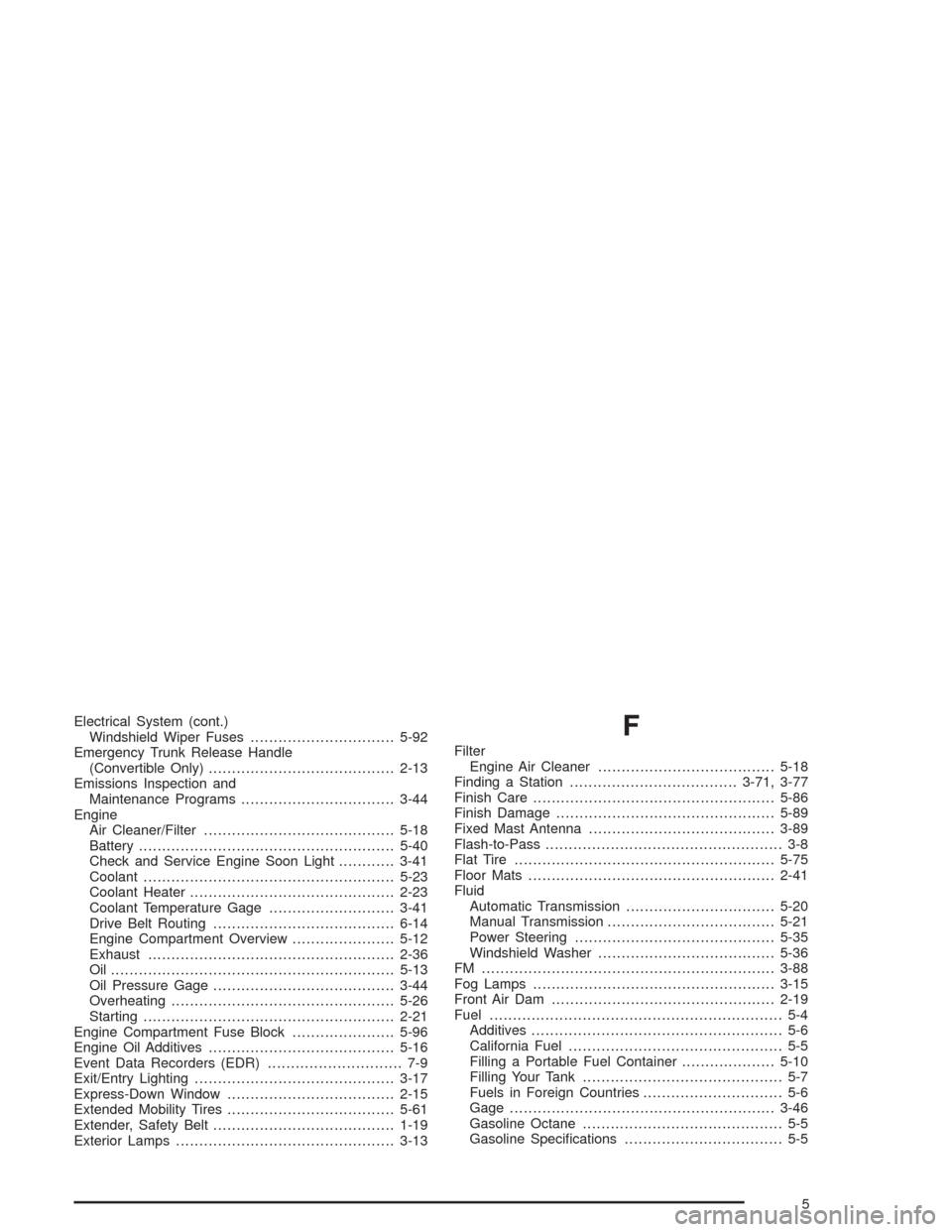
Electrical System (cont.)
Windshield Wiper Fuses...............................5-92
Emergency Trunk Release Handle
(Convertible Only)........................................2-13
Emissions Inspection and
Maintenance Programs.................................3-44
Engine
Air Cleaner/Filter.........................................5-18
Battery.......................................................5-40
Check and Service Engine Soon Light............3-41
Coolant......................................................5-23
Coolant Heater............................................2-23
Coolant Temperature Gage...........................3-41
Drive Belt Routing.......................................6-14
Engine Compartment Overview......................5-12
Exhaust.....................................................2-36
Oil .............................................................5-13
Oil Pressure Gage.......................................3-44
Overheating................................................5-26
Starting......................................................2-21
Engine Compartment Fuse Block......................5-96
Engine Oil Additives........................................5-16
Event Data Recorders (EDR)............................. 7-9
Exit/Entry Lighting...........................................3-17
Express-Down Window....................................2-15
Extended Mobility Tires....................................5-61
Extender, Safety Belt.......................................1-19
Exterior Lamps...............................................3-13F
Filter
Engine Air Cleaner......................................5-18
Finding a Station....................................3-71, 3-77
Finish Care....................................................5-86
Finish Damage...............................................5-89
Fixed Mast Antenna........................................3-89
Flash-to-Pass................................................... 3-8
Flat Tire........................................................5-75
Floor Mats.....................................................2-41
Fluid
Automatic Transmission................................5-20
Manual Transmission....................................5-21
Power Steering...........................................5-35
Windshield Washer......................................5-36
FM ...............................................................3-88
Fog Lamps....................................................3-15
Front Air Dam................................................2-19
Fuel............................................................... 5-4
Additives...................................................... 5-6
California Fuel.............................................. 5-5
Filling a Portable Fuel Container....................5-10
Filling Your Tank........................................... 5-7
Fuels in Foreign Countries.............................. 5-6
Gage.........................................................3-46
Gasoline Octane........................................... 5-5
Gasoline Specifications.................................. 5-5
5
Page 376 of 384
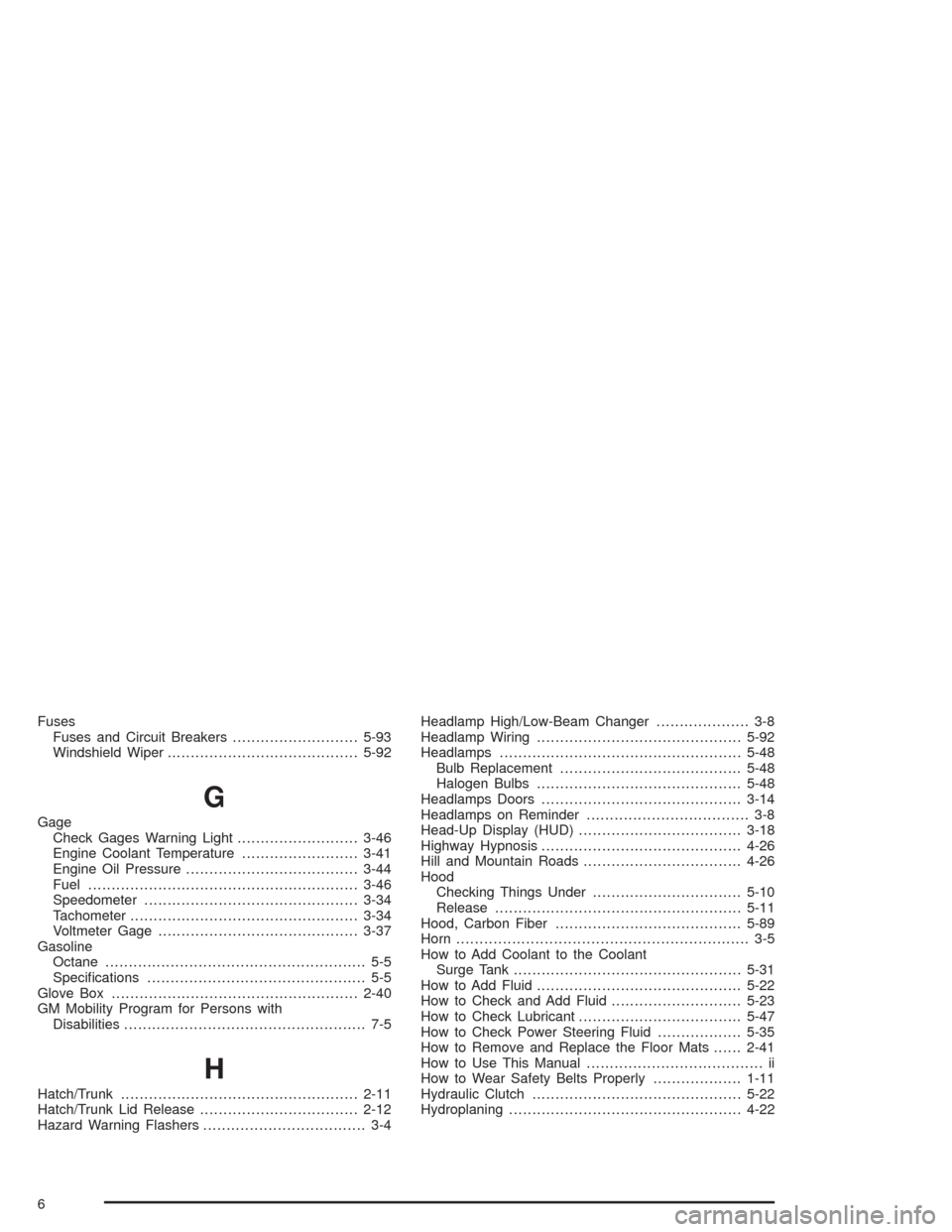
Fuses
Fuses and Circuit Breakers...........................5-93
Windshield Wiper.........................................5-92
G
Gage
Check Gages Warning Light..........................3-46
Engine Coolant Temperature.........................3-41
Engine Oil Pressure.....................................3-44
Fuel..........................................................3-46
Speedometer..............................................3-34
Tachometer.................................................3-34
Voltmeter Gage...........................................3-37
Gasoline
Octane........................................................ 5-5
Specifications............................................... 5-5
Glove Box.....................................................2-40
GM Mobility Program for Persons with
Disabilities.................................................... 7-5
H
Hatch/Trunk...................................................2-11
Hatch/Trunk Lid Release..................................2-12
Hazard Warning Flashers................................... 3-4Headlamp High/Low-Beam Changer.................... 3-8
Headlamp Wiring............................................5-92
Headlamps....................................................5-48
Bulb Replacement.......................................5-48
Halogen Bulbs............................................5-48
Headlamps Doors...........................................3-14
Headlamps on Reminder................................... 3-8
Head-Up Display (HUD)...................................3-18
Highway Hypnosis...........................................4-26
Hill and Mountain Roads..................................4-26
Hood
Checking Things Under................................5-10
Release.....................................................5-11
Hood, Carbon Fiber........................................5-89
Horn............................................................... 3-5
How to Add Coolant to the Coolant
Surge Tank.................................................5-31
How to Add Fluid............................................5-22
How to Check and Add Fluid............................5-23
How to Check Lubricant...................................5-47
How to Check Power Steering Fluid..................5-35
How to Remove and Replace the Floor Mats......2-41
How to Use This Manual...................................... ii
How to Wear Safety Belts Properly...................1-11
Hydraulic Clutch.............................................5-22
Hydroplaning..................................................4-22
6